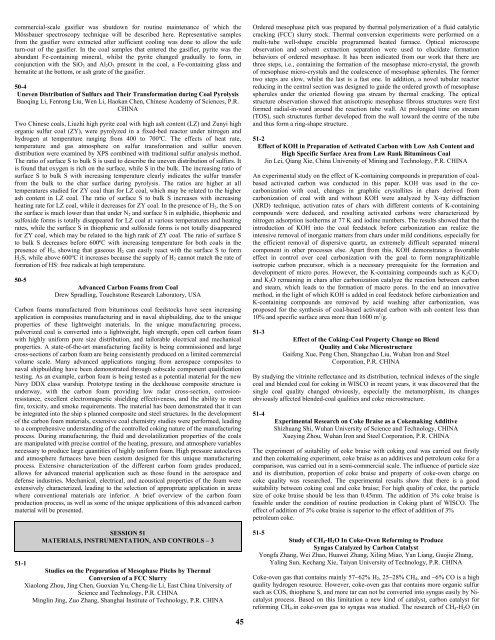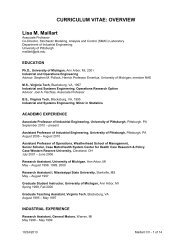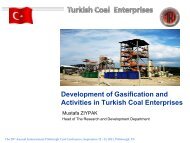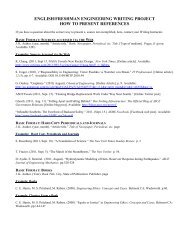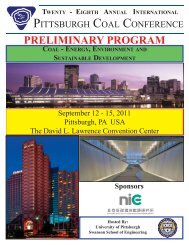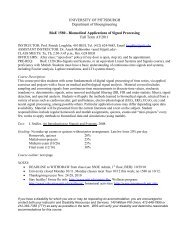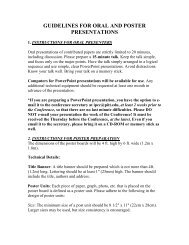Abstract Booklet 2006 - Swanson School of Engineering - University ...
Abstract Booklet 2006 - Swanson School of Engineering - University ...
Abstract Booklet 2006 - Swanson School of Engineering - University ...
You also want an ePaper? Increase the reach of your titles
YUMPU automatically turns print PDFs into web optimized ePapers that Google loves.
commercial-scale gasifier was shutdown for routine maintenance <strong>of</strong> which the<br />
Mössbauer spectroscopy technique will be described here. Representative samples<br />
from the gasifier were extracted after sufficient cooling was done to allow the safe<br />
turn-out <strong>of</strong> the gasifier. In the coal samples that entered the gasifier, pyrite was the<br />
abundant Fe-containing mineral, whilst the pyrite changed gradually to form, in<br />
conjunction with the SiO 2 and Al 2 O 3 present in the coal, a Fe-containing glass and<br />
hematite at the bottom, or ash grate <strong>of</strong> the gasifier.<br />
50-4<br />
Uneven Distribution <strong>of</strong> Sulfurs and Their Transformation during Coal Pyrolysis<br />
Baoqing Li, Fenrong Liu, Wen Li, Haokan Chen, Chinese Academy <strong>of</strong> Sciences, P.R.<br />
CHINA<br />
Two Chinese coals, Liuzhi high pyrite coal with high ash content (LZ) and Zunyi high<br />
organic sulfur coal (ZY), were pyrolyzed in a fixed-bed reactor under nitrogen and<br />
hydrogen at temperature ranging from 400 to 700ºC. The effects <strong>of</strong> heat rate,<br />
temperature and gas atmosphere on sulfur transformation and sulfur uneven<br />
distribution were examined by XPS combined with traditional sulfur analysis method.<br />
The ratio <strong>of</strong> surface S to bulk S is used to describe the uneven distribution <strong>of</strong> sulfurs. It<br />
is found that oxygen is rich on the surface, while S in the bulk. The increasing ratio <strong>of</strong><br />
surface S to bulk S with increasing temperature clearly indicates the sulfur transfer<br />
from the bulk to the char surface during pyrolysis. The ratios are higher at all<br />
temperatures studied for ZY coal than for LZ coal, which may be related to the higher<br />
ash content in LZ coal. The ratio <strong>of</strong> surface S to bulk S increases with increasing<br />
heating rate for LZ coal, while it decreases for ZY coal. In the presence <strong>of</strong> H 2 , the S on<br />
the surface is much lower than that under N 2 and surface S in sulphidic, thiophenic and<br />
sulfoxide forms is totally disappeared for LZ coal at various temperatures and heating<br />
rates, while the surface S in thiophenic and sulfoxide forms is not totally disappeared<br />
for ZY coal, which may be related to the high rank <strong>of</strong> ZY coal. The ratio <strong>of</strong> surface S<br />
to bulk S decreases before 600ºC with increasing temperature for both coals in the<br />
presence <strong>of</strong> H 2 , showing that gaseous H 2 can easily react with the surface S to form<br />
H 2 S, while above 600ºC it increases because the supply <strong>of</strong> H 2 cannot match the rate <strong>of</strong><br />
formation <strong>of</strong> HS· free radicals at high temperature.<br />
50-5<br />
Advanced Carbon Foams from Coal<br />
Drew Spradling, Touchstone Research Laboratory, USA<br />
Carbon foams manufactured from bituminous coal feedstocks have seen increasing<br />
application in composites manufacturing and in naval shipbuilding, due to the unique<br />
properties <strong>of</strong> these lightweight materials. In the unique manufacturing process,<br />
pulverized coal is converted into a lightweight, high strength, open cell carbon foam<br />
with highly uniform pore size distribution, and tailorable electrical and mechanical<br />
properties. A state-<strong>of</strong>-the-art manufacturing facility is being commissioned and large<br />
cross-sections <strong>of</strong> carbon foam are being consistently produced on a limited commercial<br />
volume scale. Many advanced applications ranging from aerospace composites to<br />
naval shipbuilding have been demonstrated through subscale component qualification<br />
testing. As an example, carbon foam is being tested as a potential material for the new<br />
Navy DDX class warship. Prototype testing in the deckhouse composite structure is<br />
underway, with the carbon foam providing low radar cross-section, corrosionresistance,<br />
excellent electromagnetic shielding effectiveness, and the ability to meet<br />
fire, toxicity, and smoke requirements. The material has been demonstrated that it can<br />
be integrated into the ship s planned composite and steel structures. In the development<br />
<strong>of</strong> the carbon foam materials, extensive coal chemistry studies were performed, leading<br />
to a comprehensive understanding <strong>of</strong> the controlled coking nature <strong>of</strong> the manufacturing<br />
process. During manufacturing, the fluid and devolatilization properties <strong>of</strong> the coals<br />
are manipulated with precise control <strong>of</strong> the heating, pressure, and atmosphere variables<br />
necessary to produce large quantities <strong>of</strong> highly uniform foam. High pressure autoclaves<br />
and atmosphere furnaces have been custom designed for this unique manufacturing<br />
process. Extensive characterization <strong>of</strong> the different carbon foam grades produced,<br />
allows for advanced material application such as those found in the aerospace and<br />
defense industries. Mechanical, electrical, and acoustical properties <strong>of</strong> the foam were<br />
extensively characterized, leading to the selection <strong>of</strong> appropriate application in areas<br />
where conventional materials are inferior. A brief overview <strong>of</strong> the carbon foam<br />
production process, as well as some <strong>of</strong> the unique applications <strong>of</strong> this advanced carbon<br />
material will be presented.<br />
SESSION 51<br />
MATERIALS, INSTRUMENTATION, AND CONTROLS – 3<br />
51-1<br />
Studies on the Preparation <strong>of</strong> Mesophase Pitchs by Thermal<br />
Conversion <strong>of</strong> a FCC Slurry<br />
Xiaolong Zhou, Jing Chen, Guoxian Yu, Cheng-lie Li, East China <strong>University</strong> <strong>of</strong><br />
Science and Technology, P.R. CHINA<br />
Minglin Jing, Zuo Zhang, Shanghai Institute <strong>of</strong> Technology, P.R. CHINA<br />
Ordered mesophase pitch was prepared by thermal polymerization <strong>of</strong> a fluid catalytic<br />
cracking (FCC) slurry stock. Thermal conversion experiments were performed on a<br />
multi-tube well-shape crucible programmed heated furnace. Optical microscope<br />
observation and solvent extraction separation were used to elucidate formation<br />
behaviors <strong>of</strong> ordered mesophase. It has been indicated from our work that there are<br />
three steps, i.e., containing the formation <strong>of</strong> the mesophase micro-crystal, the growth<br />
<strong>of</strong> mesophase micro-crystals and the coalescence <strong>of</strong> mesophase spherules. The former<br />
two steps are slow, whilst the last is a fast one. In addition, a novel tubular reactor<br />
reducing in the central section was designed to guide the ordered growth <strong>of</strong> mesophase<br />
spherules under the oriented flowing gas stream by thermal cracking. The optical<br />
structure observation showed that anisotropic mesophase fibrous structures were first<br />
formed radial-in-ward around the reaction tube wall. At prolonged time on stream<br />
(TOS), such structures further developed from the wall toward the centre <strong>of</strong> the tube<br />
and thus form a ring-shape structure.<br />
51-2<br />
Effect <strong>of</strong> KOH in Preparation <strong>of</strong> Activated Carbon with Low Ash Content and<br />
High Specific Surface Area from Law Rank Bituminous Coal<br />
Jin Lei, Qiang Xie, China <strong>University</strong> <strong>of</strong> Mining and Technology, P.R. CHINA<br />
An experimental study on the effect <strong>of</strong> K-containing compounds in preparation <strong>of</strong> coalbased<br />
activated carbon was conducted in this paper. KOH was used in the cocarbonization<br />
with coal, changes in graphitic crystallites in chars derived from<br />
carbonization <strong>of</strong> coal with and without KOH were analyzed by X-ray diffraction<br />
(XRD) technique, activation rates <strong>of</strong> chars with different contents <strong>of</strong> K-containing<br />
compounds were deduced, and resulting activated carbons were characterized by<br />
nitrogen adsorption isotherms at 77 K and iodine numbers. The results showed that the<br />
introduction <strong>of</strong> KOH into the coal feedstock before carbonization can realize the<br />
intensive removal <strong>of</strong> inorganic matters from chars under mild conditions, especially for<br />
the efficient removal <strong>of</strong> dispersive quartz, an extremely difficult separated mineral<br />
component in other processes else. Apart from this, KOH demonstrates a favorable<br />
effect in control over coal carbonization with the goal to form nongraphitizable<br />
isotropic carbon precursor, which is a necessary prerequisite for the formation and<br />
development <strong>of</strong> micro pores. However, the K-containing compounds such as K 2 CO 3<br />
and K 2 O remaining in chars after carbonization catalyze the reaction between carbon<br />
and steam, which leads to the formation <strong>of</strong> macro pores. In the end an innovative<br />
method, in the light <strong>of</strong> which KOH is added in coal feedstock before carbonization and<br />
K-containing compounds are removed by acid washing after carbonization, was<br />
proposed for the synthesis <strong>of</strong> coal-based activated carbon with ash content less than<br />
10% and specific surface area more than 1600 m 2 /g.<br />
51-3<br />
Effect <strong>of</strong> the Coking-Coal Property Change on Blend<br />
Quality and Coke Microstructure<br />
Gaifeng Xue, Peng Chen, Shangchao Liu, Wuhan Iron and Steel<br />
Corporation, P.R. CHINA<br />
By studying the vitrinite reflectance and its distribution, technical indexes <strong>of</strong> the single<br />
coal and blended coal for coking in WISCO in recent years, it was discovered that the<br />
single coal quality changed obviously, especially the metamorphism, its changes<br />
obviously affected blended-coal qualities and coke microstructure.<br />
51-4<br />
Experimental Research on Coke Braise as a Cokemaking Additive<br />
Shizhuang Shi, Wuhan <strong>University</strong> <strong>of</strong> Science and Technology, CHINA<br />
Xueying Zhou, Wuhan Iron and Steel Corporation, P.R. CHINA<br />
The experiment <strong>of</strong> suitability <strong>of</strong> coke braise with coking coal was carried out firstly<br />
and then cokemaking experiment, coke braise as an additives and petroleum coke for a<br />
comparison, was carried out in a semi-commercial scale. The influence <strong>of</strong> particle size<br />
and its distribution, proportion <strong>of</strong> coke braise and property <strong>of</strong> coke-oven charge on<br />
coke quality was researched. The experimental results show that there is a good<br />
suitability between coking coal and coke braise; For high quality <strong>of</strong> coke, the particle<br />
size <strong>of</strong> coke braise should be less than 0.45mm. The addition <strong>of</strong> 3% coke braise is<br />
feasible under the condition <strong>of</strong> routine production in Coking plant <strong>of</strong> WISCO. The<br />
effect <strong>of</strong> addition <strong>of</strong> 3% coke braise is superior to the effect <strong>of</strong> addition <strong>of</strong> 3%<br />
petroleum coke.<br />
51-5<br />
Study <strong>of</strong> CH 4 -H 2 O In Coke-Oven Reforming to Produce<br />
Syngas Catalyzed by Carbon Catalyst<br />
Yongfa Zhang, Wei Zhao, Huawei Zhang, Xiling Miao, Yan Liang, Guojie Zhang,<br />
Yaling Sun, Kechang Xie, Taiyan <strong>University</strong> <strong>of</strong> Technology, P.R. CHINA<br />
Coke-oven gas that contains mainly 57~62% H 2 , 25~28% CH 4 , and ~6% CO is a high<br />
quality hydrogen resource. However, coke-oven gas that contains more organic sulfur<br />
such as COS, thiophene S, and more tar can not be converted into syngas easily by Nicatalyst<br />
process. Based on this limitation a new kind <strong>of</strong> catalyst, carbon catalyst for<br />
reforming CH 4 .in coke-oven gas to syngas was studied. The research <strong>of</strong> CH 4 -H 2 O (in<br />
45


